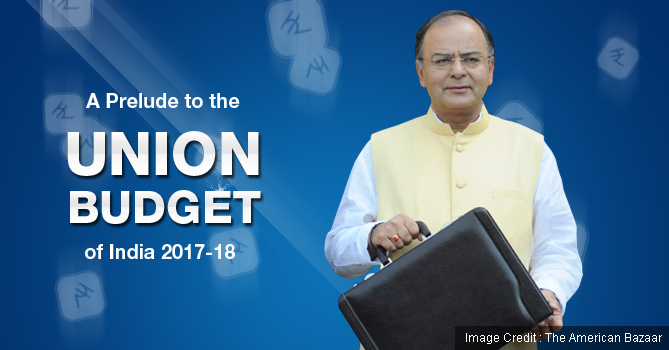As the Finance Minister Arun Jaitley prepares to present the Union Budget of India for the financial year 2017-18, the common man is worried not knowing what’s in store for him. Demonetisation has hit the common man the most with cash crunch, impacting jobs and business opportunity losses. So what can the country expect from the Finance Minister?
The common man expects the government to speed up the process of remonetisation and ensure adequate cash is introduced into circulation. Next, the common man would like the FM to announce a reduction in income tax along with an increase in the income tax exemption limit. The Central Statistics Organization (CSO) has come out with the latest figures that points to a slowing economy.
The GDP is expected to be at 7.1% and this does not include the impact of demonetisation. So, the actual GDP may dip to anywhere between 5.2% 5.7%. Therefore, the industry will expect the government to either announce a reduction in Corporate tax or at least a further reduction in interest rates, over and above what has recently been announced. Another major expectation will be a speeding up of the disinvestment process of non-performing PSUs.
While one will have to wait for the budget to be announced, many citizens are still not clear on what it really is and what’s the purpose behind the exercise.
The Cabinet Committee on Parliamentary Affairs has made a recommendation for the Budget session to commence from January 31, 2017, and the Union Budget to be presented on February 1, 2017 by the Finance Minister.
Unlike in earlier years, the Union Budget will be presented on February 1 and not on February 28, as has been the practice thus far. In another break from standard practice, the Railway Budget will be presented along with the Union Budget. The Railways Budget was always presented separately and this will be a first when both budgets will be presented together.
At the time of writing, political parties in opposition have approached the Election Commission to defer the Budget presentation date citing close proximity to the forthcoming Assembly elections. It remains to be seen whether the EC will comply.
What is the Union Budget?
Article 112 of the Indian Constitution states that the Annual Financial Statement of the government is the estimated revenues and estimated expenditure of the government for the financial year. Financial year is stated as starting from April 1 to March 31. The Union Budget gives the overall current picture of the financial status of the country and the plan for the coming year.
Components of the Union Budget
The Union Budget has two parts:
- Revenue Budget
- Capital Budget
Revenue Budget (Revenue receipts and Revenue expenditure)
Government earns revenue called Revenue Receipts, from Direct and Indirect tax collections.
Sources of Revenue Receipts
Direct taxes
These are governed by the Central Board of Direct Taxes (CBDT) and Central Board of Excise and Customs (CBEC). The main sources of direct taxes are:
- Income Tax: Collected from individuals;
- Wealth Tax: Collected from high income individuals, in addition to Income tax;
- Property Tax/ Capital Gains Tax: Tax levied on profit from selling real estate assets and stocks;
- Gift Tax/ Inheritance tax: Tax levied on money received by individuals as gifts;
- Corporate Tax: Tax levied on the income of companies and happens to be one of the largest sources of income for the government.
Indirect Taxes
- Service Tax: Tax charged by service providers and submitted to the government;
- Excise Duty: Duty levied on manufactured goods (for domestic consumption) at the time when they leave the factory;
- Custom Duty: Duty levied on goods imported into the country;
- Sales Tax and VAT: Tax levied on sale of goods in the country;
- Security Transaction Tax (STT): Tax collected from sale/ purchase of stocks, shares, and other financial products.
Revenue Expenditure
Expenditure incurred by the government on:
- Repayment of government debt: Repayments of loans and other borrowings;
- Expenses on various subsidies: Cost absorbed by the government to ensure lower cost to end consumers, example subsidized food, fertilizer, electricity, etc.
- Expenses on services: Expense incurred on providing medical services, educational services, legal services, defence services, etc.
Note:
When the government’s total revenue expenditure exceeds total revenues, the government is said to incur a Revenue deficit.
Capital Budget (Capital receipts and Capital expenditure)
Capital Receipts
Income from loans and borrowings from public, international governments and institutions, and domestic institutions like RBI, money raised from Public Provident Fund (PPF) and from small savings of depositors etc., form the core of government’s sources for capital receipts.
Capital expenditure
- Purchases of machinery etc.;
- Infrastructure development: Cost incurred by government in building roads, dams, bridges, airports, metros etc.;
- Defence Spending: Cost incurred in maintaining the defence forces, buying weapons and equipment etc.
Note:
When the total capital expenditure exceeds total capital receipts, the government is said to incur a Fiscal deficit.
What is Budget deficit?
When the total estimated expenditure (Revenue + Capital) exceeds the total estimated receipts (Revenue + Capital), the government is said to incur a Budget Deficit.
Did you know these interesting but factual information about the Union Budget?
- It was on April 7, 1860 when East India Company presented the budget to the British Crown.
- The British had followed a tradition since 1860, when the budget was carried in a red Gladstone Box; in India, we have followed the tradition on similar lines wherein the Finance Minister carries the budget in a bag in a ceremonial process to Parliament.
- It was R.K. Shanmukham Chetty who holds the honour of presenting the first Union Budget of Independent India, on November 26, 1947.
- Former Prime Minister and Finance Minister Morarji Desai holds the record of having presented the maximum number of Union Budgets – 10 annual budgets. The current President of India Pranab Mukherjee has presented the next highest number of budgets – 7.
- Former Prime Minister Indira Gandhi was the only woman to present the budget when she was the Finance Minister for the year 1970-71.
- 1991-92 is the only year when the Final budget and the Interim budget were presented together by ministers representing two different political parties. Yashwant Sinha presented the Final budget while Manmohan Singh presented the Interim budget. This was also a landmark year when the government opened up the economy when Manmohan Singh announced a custom duty reduction from 300% to 50%.
- The preparation of the Union Budget begins around September – October every year when concerned government staff begin to assimilate all information collected from different departments and state governments.
- The Union Budget goes into printing around a week before the actual budget is presented by the FM and is done under complete secrecy. The process commences with a Halwa ceremony amongst the relevant officers and staff, all of whom remain isolated within the confines of the Finance Ministry located in North Block, New Delhi, till the time the Budget is presented in Parliament. During this period, they are not allowed to have contact with anyone including their families.
- The timing of presenting the budget was also crucial. The British Budget would be passed at noon in their Parliament and was followed by the Indian Budget at 5 pm local time on the last working day of February, and this tradition carried on till 1999. It was only in 2001, when the then Finance Minister Yashwant Sinha broke the tradition and presented the Union Budget at 11 am. Ever since then, all budgets have been presented in the morning at 11 am on the last day of February. This year might see a break from that tradition.





